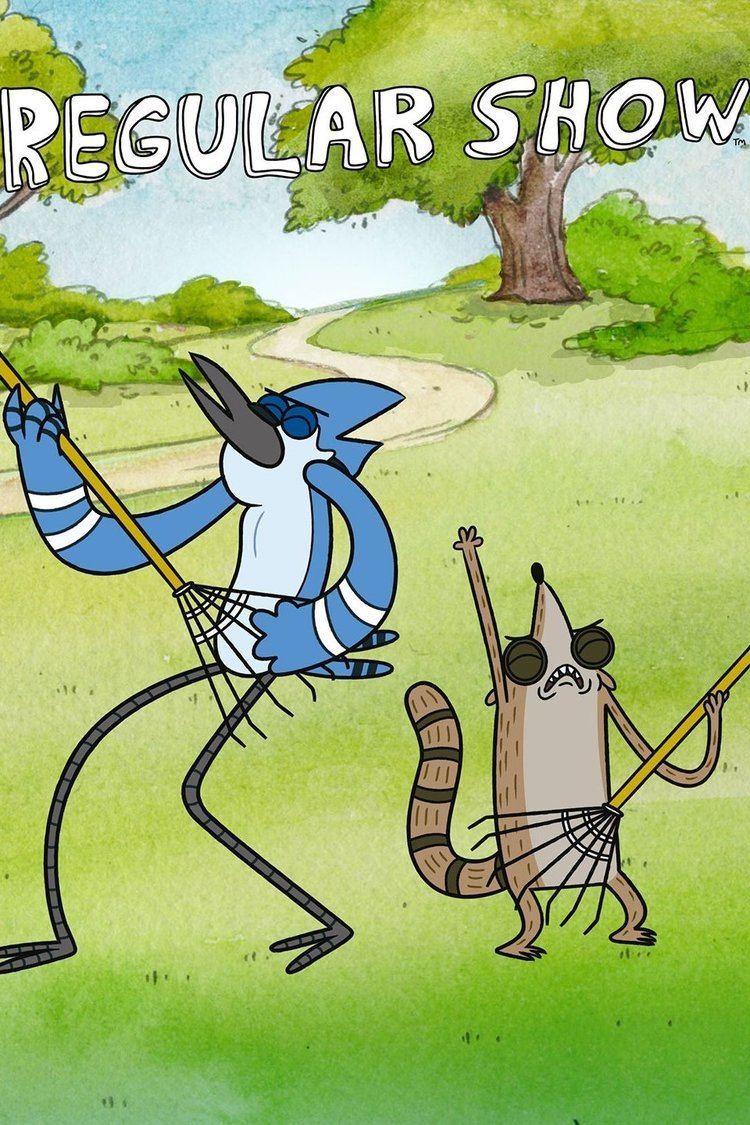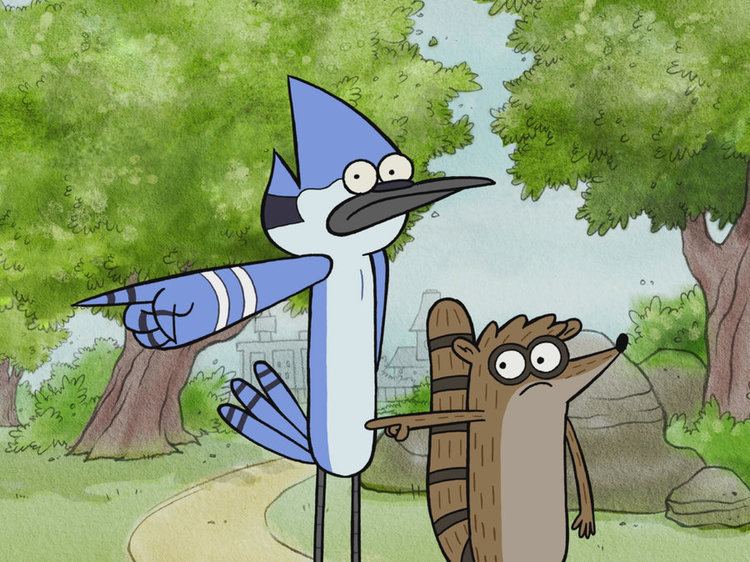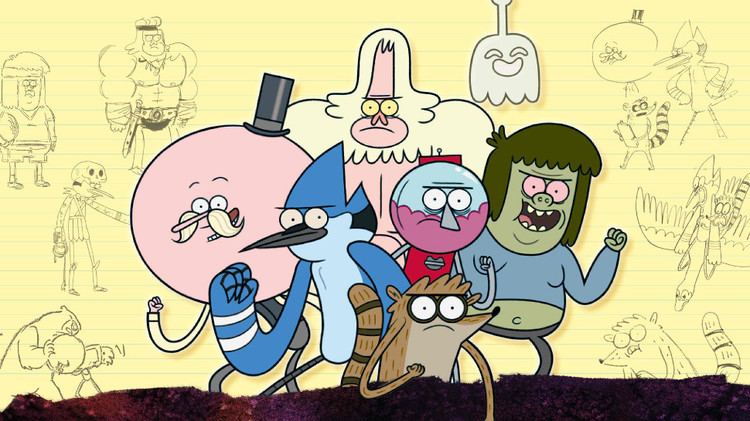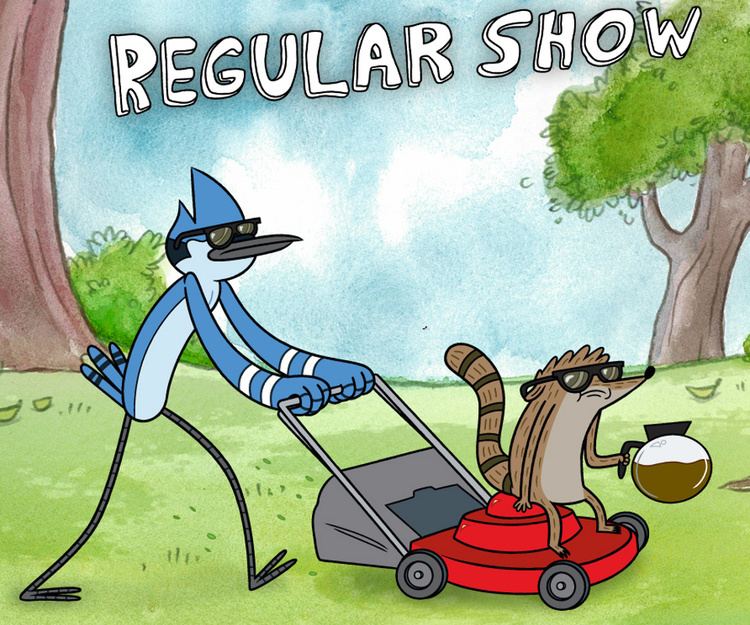8.4 /10 1 Votes
8.2/10 TV First episode date 6 September 2010 | 8.4/10 IMDb Created by J. G. Quintel Final episode date 16 January 2017 | |||||||||||||||||||||||||||||||||
 | ||||||||||||||||||||||||||||||||||
Also known as Regular Show in Space (season 8) Genre SitcomComedy-DramaAdventureScience fantasy Directed by Paula Spence (Art Director)John Infantino (Supervising Director, seasons 2–6)Robert Alvarez (Animation Director)J. G. Quintel (2012–2014)Mike Roth (2012–2013)Sean Szeles (Supervising Director, seasons 4–6)Calvin Wong (Supervising Director, season 7–8) Creative director(s) Mike Roth (season 1)John Infantino (season 2) Voices of J. G. QuintelWilliam SalyersSam MarinMark HamillJanie Haddad TompkinsMinty Lewis Characters Mordecai, Rigby, Pops Maellard, High Five Ghost, Low Five Ghost Profiles | ||||||||||||||||||||||||||||||||||
Regular Show (known as Regular Show in Space during its final season) is an American animated television series created by J. G. Quintel for Cartoon Network that premiered on September 6, 2010. The series revolves around the lives of two working-class friends, a blue jay named Mordecai and a raccoon named Rigby—both employed as groundskeepers at a local park. Their regular attempts to slack off usually lead to surreal, extreme, and often supernatural misadventures. During these misadventures, they interact with the show's other main characters: Benson, Pops, Muscle Man, Hi-Five Ghost, Skips, Margaret and Eileen.
Contents
- Premise
- Creation
- Writing
- Voice cast
- Animation
- Music
- Episodes
- Crossovers
- Ratings
- Critical reception
- Comic books
- Video games
- Other merchandise
- Film
- References

Many of Regular Show's characters are loosely based on those developed for Quintel's student films at California Institute of the Arts: The Naïve Man from Lolliland and 2 in the AM PM. Quintel pitched Regular Show for Cartoon Network's Cartoonstitute project, in which the network allowed young artists to create pilots with no notes, which would possibly be optioned as shows. The project was green-lit and it premiered on September 6, 2010.

As of May 2013, the program has been watched by approximately 2 to 2.5 million viewers each week. The series has received positive reviews from critics and has developed a following of all ages. Regular Show has been nominated for several awards, including two Annie Awards and four Primetime Emmy Awards—one of which it won for the episode "Eggscellent" (season 3, episode 18). A film based on the series, titled Regular Show: The Movie, premiered in 2015.
After eight seasons and 261 episodes, the series concluded on January 16, 2017 with the one-hour finale "A Regular Epic Final Battle".

Premise

The series is set in the fictional town of West Anderson, California. It revolves around the daily lives of two 23-year-old friends, Mordecai (a blue jay), and Rigby (a raccoon). They work as groundskeepers at a park, and spend their days trying to avoid work and entertain themselves by any means. This is much to the chagrin of their manager/boss Benson (a gumball machine) and their coworker Skips (a yeti), but to the delight of their (other) manager/boss Pops (a man with a lollipop-shaped head). Other coworkers include an overweight green man called Muscle Man, and a ghost called Hi-Five Ghost.
Creation

Regular Show largely grew out of creator J. G. Quintel's life and experiences in college. Quintel attended the California Institute of the Arts, and many of the characters on Regular Show are based on the characters developed for his student films The Naïve Man from Lolliland (2005) and 2 in the AM PM (2006). Both originated as part of a game called "48-hour films", in which students put words into a hat, pulled out one word at midnight and spent a weekend developing ideas for a film. Quintel attended college with Thurop Van Orman and Pendleton Ward, who both went on to work at Cartoon Network Studios with Quintel; Van Orman created The Marvelous Misadventures of Flapjack and Ward created Adventure Time. Quintel concurrently worked on Camp Lazlo and as creative director on The Marvelous Misadventures of Flapjack while completing his degree. He was later invited to pitch for Cartoon Network's Cartoonstitute, a project to showcase short films created without the interference of network executives and focus testing,
J. G. Quintel returned to the characters from his films, put them together with newer characters and created a pilot. Quintel wanted to present a visual pitch rather than a verbal one, believing the idea would make little sense otherwise. He storyboarded the idea for the pilot, and Craig McCracken and Rob Renzetti liked his presentation. Regular Show was one of two series from the project that were green-lit (the other show being Secret Mountain Fort Awesome, based on the Cartoonstitute short Uncle Grandpa, which in turn became its own series later on). The project was eventually scrapped and never premiered on television. The character of Mordecai embodies Quintel during his college years, specifically at CalArts; Quintel said, "That's that time when you're hanging out with your friends and getting into stupid situations, but you're also taking it seriously enough." The character of Rigby was randomly developed when Quintel drew a raccoon hula-hooping. He liked the design and developed the character of Rigby to be far less responsible than his companion.
The show is inspired by some British television series and video games. Episodes are produced using storyboarding and hand-drawn animation, and each episode takes roughly nine months to create. Quintel recruited several independent comic book artists to draw the show's animated elements; their style matched closely Quintel's ideas for the series. The show's soundtrack comprises original music composed by Mark Mothersbaugh and licensed songs. While preparing for the beginning of the show, Quintel looked for young, independent, comic artists to compose the show's storyboard artists; he thought that the style would closely match that of Regular Show. He looked through blogs and convention panels for the "total package", which he said was the ability to write and draw; something that many independent comic book artists possess. In addition, Quintel attended many open shows at CalArts—an eight-hour festival of student animation. The style and sensibility of Regular Show was difficult to work with in the beginning; the artists struggled to create a natural, sitcom-like sound for the series.
Regular Show was inspired by The Simpsons and Beavis and Butt-Head, and Quintel credited the stylistic elements of Joe Murray's Rocko's Modern Life and Camp Lazlo as working their way into his style. Video games Street Fighter, Shadowrun and ToeJam & Earl — which Quintel played when he was a child — inspired the series, as did some British television programs. Quintel's interest in British television was influenced by his British roommate at CalArts, who introduced him to The League of Gentlemen, The IT Crowd, Little Britain, The Office and The Mighty Boosh; the latter was very influential to Quintel and would later influence the humor in Regular Show.
Writing
The process of writing a script for Regular Show begins with the staff writers playing "writers games" for inspiration to find an idea that they find enjoyable. Once an idea is approved, the premise of the episode is written and passed to the storyboard artists, who create the dialogue. The writers try to make the conversations feel natural to the audience, using examples from their own experiences. The script is then shown to the network executives, who give notes on what should be added or changed.
The plot generally begins with a basic problem that the characters must overcome. While the protagonists work on their task, a magical, supernatural, or strange element appears and complicates the initially simple problem. The writers decided to follow this narrative structure to take advantage of the animation.
The series is rated TV-PG-V. Cartoon Network told Quintel early on that they wanted to "age it up from the TV-Y7 stuff we'd been doing in the past". This direction led the crew to use adult-oriented humor with innuendos and drug and alcohol references because they wanted to cater for both the younger and adult audiences. The writers generally make these jokes subtle. The show also makes use of sub-textual adult humor through music. One of the program's storyboard artists, Calvin Wong, said that he enjoys the limitations set by writing for the show since the adult-oriented jokes that are approved are satisfying.
The plots of the episodes are influenced by the writers' and Quintel's personal experiences, such as performing prank telephone calls or accepting an eating challenge from a restaurant. The show often references 1980s culture, using music and electronic devices from that era because many factors from the decade left a positive influence on Quintel. The show also makes references to modern social trends such as viral internet videos.
Voice cast
The voice acting of the series is relatively low-key, and the intention was to make most of the characters sound natural and conversational. Quintel wanted to make the show listenable and given contrast to most other cartoons, which often are difficult for adults to listen to. The main cast consists of voice acting veterans Mark Hamill, who portrays Skips and Roger Craig Smith, who plays Thomas. William Salyers plays the voice of Rigby, Janie Haddad portrays Margaret and Quintel's former CalArts classmate Sam Marin voices Benson, Pops, and Muscle Man. Quintel portrays Mordecai and Hi-Five Ghost. Members of the production staff have voiced several characters throughout the series; these include Minty Lewis, Toby Jones, Andress Salaff, and Matt Price. The Regular Show cast record their lines together in group as opposed to individual recording sessions for each actor; this is to help the show's dialogue sound natural. The series regularly uses guest voice actors for recurring characters; these guests include Steven Blum, Courtenay Taylor, David Ogden Stiers, Robin Atkin Downes, Jeff Bennett, Jennifer Hale, David Kaye, Fred Tatasciore and Julian Holloway.
Animation
Each episode of Regular Show takes about nine months to complete. Quintel and his 35-member team develop each episode at Cartoon Network Studios in Burbank, California. The script is illustrated in rough hand-drawn images, known as storyboards. The storyboards are then animated and mixed with the corresponding dialogue to create the animatic, which is then sent to be approved by the network. The show's assets (backgrounds, character designs, props) are then assembled to be sent to Saerom Animation in South Korea, where the actual animation production of the episode is performed. When finished, the episode is sent to Sabre Media Studios back in California. Music and sound effects are created and the final episode is mixed and completed. The process allows the production team to work concurrently on dozens of episodes at different stages of production.
Although most modern animation has switched to hybrid methods such as the Cintiq, Regular Show has been described as "far more low-fi", and is animated traditionally by hand using paper which is then digitally composited and painted with digital ink and paint. Although Cintiqs were initially optioned to be used for the program, Quintel has stated that he has felt more comfortable working on paper, considering it to be more organic and more representative of each artist's individual style. Board artist Calvin Wong said, "the tools of the trade as being pencils, pens, white out and occasionally light boxes and electric erasers".
Music
Regular Show has no regular theme music; instead at the beginning of each episode, a blurred sound (provided by Quintel) followed by a ticking a clock is heard over the title cards. The main composer of the series is Mark Mothersbaugh, one of the founding members of the band Devo. As Quintel was developing the pilot he considered asking Mothersbaugh to create the music for the show. The episode's animatic was sent to Mothersbaugh along with a request for him to join the show's staff and crew.
Regular Show will occasionally make use of licensed songs—mostly from the 1980s; this began when Quintel and the staff writers started recording the animatics using copyrighted songs for the montage scenes. The network executives watched the animatic and asked the crew if they wanted to use some of the songs for the finished episodes. Quintel said that the songs are chosen for their suitability for the scene, whether they sound good and are affordable. Quintel enjoys using the songs in the episodes because adult viewers might remember them and younger viewers might appreciate older music. Songs have included "You're the Best Around", "Mississippi Queen" and "A Holly Jolly Christmas".
The show also produces original songs which are used on the episodes. These are generally composed by Mothersbaugh and written by one of the staff's storyboard artists. "Summertime Loving, Loving in the Summer (Time)" was written by the staff member Sean Szeles and appeared in the episode "This Is My Jam" (season 2, episode 13).
Episodes
Most episodes of Regular Show last 11 minutes; episodes are usually paired together to fill a half-hour program slot. 261 episodes in eight seasons have been completed and broadcast. The first season began on September 6, 2010, with the episode "The Power" and ended on November 22, 2010, with "Mordecai and the Rigbys". The second season began on November 29, 2010, with "Ello Gov'nor" and ended on August 1, 2011, with "Karaoke Video". The third season premiered on September 19, 2011, with the episode "Stick Hockey" and concluded on September 3, 2012, with "Bad Kiss". The fourth season premiered on October 1, 2012, with the half-hour special "Exit 9B" and concluded on August 12, 2013 with "Steak Me Amadeus". The fifth season premiered on September 2, 2013, with the episodes "Laundry Woes" and "Silver Dude" and concluded on August 14, 2014, with "Real Date". The sixth season premiered on October 9, 2014, with "Maxin' and Relaxin'", and ended on June 25, 2015 with "Dumped at the Altar". The seventh season premiered with "Dumptown USA" on June 26, 2015 and ended with the half-hour "Rigby's Graduation Day Special" on June 30, 2016. The eighth and final season, titled Regular Show in Space, started on September 26, 2016 with "One Space Day at Time" and ended on January 16, 2017 with "A Regular Show Epic Final Battle".
Crossovers
Mordecai and Rigby had cameo appearances on the Uncle Grandpa episode "Pizza Eve", along with other Cartoon Network characters from currently running and ended cartoons.
Mordecai, Rigby and High Five Ghost, make a small cameo in The Amazing World of Gumball episode "The Boredom", along with the titular characters from Uncle Grandpa and Clarence.
Ratings
Regular Show became an instant hit. Its first and second seasons, broadcast on Monday nights, ranked number one in its time slot among all key boy demos across all of television according to Nielsen Media Research. The pilot's premiere was watched by 2.097 million viewers. For the following episodes of the first season, viewership increased by over 10 percent from the time period of the previous year. For instance, the entry was viewed by 1.339 million children aged 2–11, a 65 percent increase from the previous year. It was also watched by 716,000 children aged 9–14; a 43 percent increase. The second season premiere, "Ello Gov'nor", marked a decline from the first season premiere's figures. It gained 2.067 million views, but it marked an increase from the first season finale, which was watched by 2.028 million viewers. The third season premiere, "Stick Hockey", saw a bigger decline in viewers, recording 2 million views. As the series continued its ratings grew; the fourth season premiere, "Exit 9B", was watched by 3.047 million viewers—a significant increase from previous seasons.
Critical reception
Regular Show received critical acclaim from critics. A reviewer from IGN, R.L. Shaffer, called the show zany, absurd, bizarre, and hilarious. He praised the show's writing, and said that it included "snappy dialogue, odd characters, and clever stories—each more irrelevant than the last—Regular Show never ceases to tickle the funny bone". He finished his review by calling the show "a pretty awesome piece of refreshing off-the-wall comedy" and wrote that it's "humorously animated, brazenly silly and almost always funny".
DVD Talk's Neil Lumbrad described the show as "offbeat sense of humor with a lot of randomness that makes its title both peculiar and hilarious" and compared it to the original Looney Tunes shorts and other cartoons—including The Powerpuff Girls, Dexter's Laboratory, and Johnny Bravo—which Cartoon Network has produced. He wrote that the network has found "animated gold with Regular Show, which is too offbeat and unique to be called regular" and that it is a "comedic animated gem worthy of being discovered for years to come". Lumbrad ended his review by recommending the show and calling it "one truly awesome cartoon with a lot of good humor to enjoy."
The A.V. Club's critic, Alasdair Wilkins, said that compared to Cartoon Network's other animated comedy, Adventure Time, he does not consider the series to be funny, and describing it as "more pleasingly weird". He said that the episodes' plots can occasionally be too complex to explore completely in the show's 11 minutes, and also said that the usual story setup can make some stories feel structurally the same as others. Wilkins said that he considers that the show is at its best when it focuses on the jokes, the character moments and inventive ways to use animation. Kevin McFarland, also of The A.V. Club, said that he considers the series a thrill to watch; he complemented the animation style, the characters, and the use of motifs.
Comic books
In January 2013, Boom! Studios announced that it would develop a comic book series based on the show and that KC Green would be writing the script and Allison Strejlav would be in charge of the illustrations. The first issue officially was released on May 15, 2013.
A series of original graphic novels began publication in 2014. The first, titled Hydration, was written by Rachel Connor and illustrated by Tessa Stone. It was followed by Noir Means Noir, Buddy (2015), A Clash of Consoles (2016), and Wrasslesplosion (2017).
Video games
The show has an app called Nightmare-athon available on the iOS app store. A new app has been released called "Ride 'Em Rigby". On April 8, 2013, J. G. Quintel announced on his Twitter page that an official Regular Show video game was in development at the time, which is titled Regular Show: Mordecai and Rigby In 8-Bit Land. It was developed by WayForward Technologies and published by D3 Publisher for Nintendo 3DS. The video game was released on October 29, 2013.
Other merchandise
Jazwares has produced an assortment of 2-, 6-, 7-, and 10-inch licensed action figures and plush toys for the series. "Collectable Figures" have also been released along with other themed merchandise, such as "80's Bobbleheads", "Pullback Custom Cruisers" and "Wrestling Buddies". There have been many graphic T-shirts officially licensed through clothing retailers Hot Topic, We Love Fine, and Threadless. Looney Labs also released a Regular Show-themed version of the card game Fluxx on July 25, 2014.
Film
At the Cartoon Network 2015/2016 upfront, it was announced they were making Regular Show: The Movie.
After accidentally creating a "Timenado," slacker groundskeepers Mordecai and Rigby go back in time and battle an evil volleyball coach in order to save the universe — and their friendship.
It first screened at the Downtown Independent in LA on August 14, 2015. It was released to digital download on September 1, 2015, it was also released to DVD by Warner Home Video on October 13, 2015, and had its television premiere on November 2015. The movie also screened at select Alamo Drafthouse Cinemas across the United States and it had a select showtime at the SVA Theatre of New York and at the Cinema Montrereal CANADA during October 2015.
